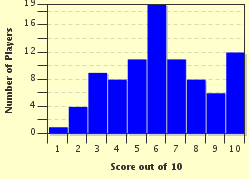Quiz Answer Key and Fun Facts
1. Which of the following best describes rheumatoid arthritis?
2. Sounding like a villa in Spain, which of the following refers to a softening of the articular cartilage within the knee?
3. Cruciate ligament injuries are generally referred to as sprains.
4. Which of the following collateral ligaments is the more easily injured?
5. Which of the following best describes tendonitis?
6. The menisci are the shock absorbers for your knees.
7. Osgood-Schlatter Disease (OSD), which is localised to the growth area of the upper tibia, commonly affects which age group?
8. A band of tissue rubs over the lateral condyle (outer bone of the knee) causing inflammation. This condition is known as which of the following?
9. Plica syndrome is one of the easiest knee problems for doctors to diagnose.
10. Osteochondritis Dissecans (OCD) occurs in joints and sees small segments of bone separate from their surrounding areas due to a lack of which of these?
Source: Author
pollucci19
This quiz was reviewed by FunTrivia editor
rossian before going online.
Any errors found in FunTrivia content are routinely corrected through our feedback system.

